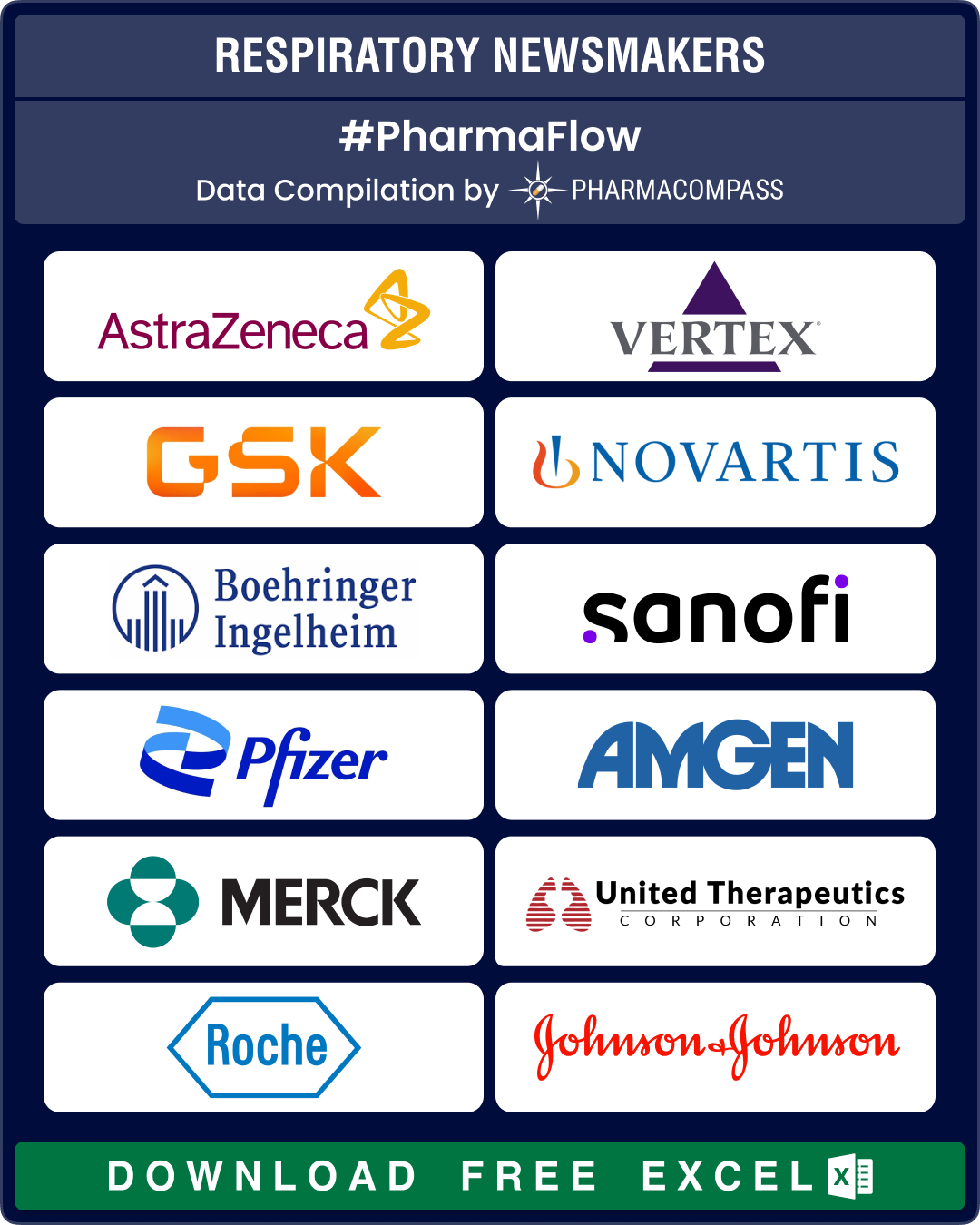
By PharmaCompass
2022-12-22
Impressions: 2748
Respiratory health came into the limelight during the pandemic, as millions died of lung-related ailments across the world. However, even prior to Covid-19, respiratory diseases had been growing at a fast pace due to increase in pollution and the consumption of tobacco. The SARS-CoV2 virus only added to those numbers.
Major respiratory illnesses include asthma, chronic obstructive pulmonary disease (COPD), cystic fibrosis (CF), idiopathic pulmonary fibrosis (IPF), respiratory distress syndrome and pulmonary arterial hypertension (PAH).
The global market for respiratory drugs was estimated at US$ 142.57 billion in 2021 and is expected to reach US$ 292.01 billion by 2026, growing at a compounded annual growth rate of 17.2 percent.
Major players in the segment are AstraZeneca, Novartis, GSK, Vertex, Boehringer Ingelheim, Sanofi, Regeneron, Amgen, Pfizer, Merck, United Therapeutics, Roche and Janssen. Emerging players like Transpire Bio, Vicore and Verona Pharma are also working on promising respiratory drugs.
Access the Respiratory Newsmakers Dashboard (Free Excel)Sanofi’s Dupixent, Astra’s Fasenra, GSK’s Nucala being explored for COPD
Some of the largest selling respiratory drugs are those that treat COPD and asthma, such as AstraZeneca’s Symbicort (budesonide/formoterol) and Fasenra (benralizumab), Boehringer Ingelheim’s Spiriva (tiotropium bromide) and GSK’s Trelegy Ellipta (fluticasone furoate/vilanterol/umeclidinium), Nucala (mepolizumab) and Seretide/Advair (fluticasone propionate/salmeterol).
Nucala, which has been approved for eosinophilic asthma, is currently being investigated for COPD and is in phase 3 trials. Astra is also carrying out a phase 3 trial of Fasenra as a treatment for COPD. The drug is already approved for the treatment of eosinophilic asthma.
Sanofi and Regeneron’s Dupixent (dupilumab) was first approved by the FDA in 2017 as a treatment for eczema. In 2018, the approval was expanded for moderate-to-severe asthma, and since then it has been approved for nasal polyposis, eosinophilic esophagitis and prurigo nodularis (a chronic, debilitating skin disease). Though an important dermatology drug, Dupixent is also being explored as a treatment for COPD. Sanofi expects to file a supplemental BLA for Dupixent (as a treatment for COPD) in the US in 2024. Sanofi is targeting €13 billion (US$ 14.3 billion) in peak Dupixent sales, excluding COPD. Last year, the drug posted US$ 6 billion in sales.
In March 2022, FDA approved Viatris’ Breyna as the first generic of Astra’s Symbicort, an asthma and COPD drug. However, a West Virginia court has ruled in favor of AstraZeneca, adding six months of patent protection for this blockbuster. In November this year, AstraZeneca inked a potential US$ 402 million licensing deal with British drug discovery firm C4X Discovery Holdings to develop an oral treatment for COPD along with other inflammatory and respiratory illnesses.
Among the most anticipated treatments for asthma and COPD are AstraZeneca and Avillion’s PT027 (albuterol/budesonide) as a treatment for asthma. In November 2022, a panel of experts to the FDA voted overwhelmingly (16 to 1) in favor of PT027 and the FDA is slated to decide on the drug’s approval by the first half of 2023. Similarly, AstraZeneca’s tozorakimab is currently in phase 3 for COPD. GSK’s depemokimab, a long acting anti-IL5 monoclonal antibody, is currently in phase 3 for the treatment of asthma. And Sanofi and Regeneron’s itepakimab, an anti-IL-33 monoclonal antibody, is currently in phase 3 for the treatment of COPD.
Access the Respiratory Newsmakers Dashboard (Free Excel)
Vertex’s cystic fibrosis drug Trikafta to clock US$ 7.2 billion in 2024 sales
Vertex’s Trikafta was approved by the FDA in October 2019 as treatment for cystic fibrosis (CF). This blockbuster respiratory drug brought in sales of US$ 5.7 billion in 2021. Trikafta’s global peak sales are expected to reach US$ 7.2 billion in 2024, though there is all likelihood that the drug may cross the US$ 7-billion sales mark this year itself (it posted sales of US$ 5.7 billion in the first nine months of 2022). Vertex plans to file for approval of the drug as a treatment for CF in children between two and five years of age soon.
Pulmonary arterial hypertension (PAH) is a type of high blood pressure that affects the arteries in the lungs and the right side of the heart. This year saw some drugs bag approval for this condition. In June this year, FDA approved CMP Pharma’s Tadliq (tadalafil) liquid oral suspension for the treatment of PAH. Tadliq is the first and only FDA-approved liquid oral suspension of tadalafil. And in May this year, FDA granted approval to United Therapeutics’ Tyvaso DPI (dry powder formulation) for the treatment of PAH and pulmonary hypertension associated with interstitial lung disease (PH-ILD).
PAH was also a key reason why Merck acquired Acceleron Pharma last year for US$ 11.5 billion. Under the terms of the agreement, Merck gained access to Acceleron’s experimental PAH drug – sotatercept – along with other products. In October this year, sotatercept met the main goal in patients with a progressive blood vessel disorder in a late-stage clinical trial. The drug is expected to be launched in the US in 2024 and in the rest of the world in 2025. Similarly, Janssen’s Uptravi (selexipag) tablet is currently in a phase 3 trial for children with PAH. In 2021, selexipag received US approval for intravenous use in adult patients with PAH.
Access the Respiratory Newsmakers Dashboard (Free Excel)
GSK, Pfizer, Moderna, Janssen work on RSV vaccines
Respiratory syncytial virus (RSV) is a common respiratory virus that usually causes mild, cold-like symptoms. Most people recover in a week or two, but RSV can be serious, especially for infants and older adults.
According to Nature, each year 3 million children under the age of five and approximately 336,000 older adults get hospitalized due to respiratory tract infections caused by RSV. For decades, researchers have been unsuccessful in developing an RSV vaccine. But now, several RSV vaccine candidates are in clinical trials, while one antibody therapy has bagged authorization in the EU.
The RSV vaccine pipeline includes candidates from GSK (RSVPreF3 OA vaccine), Pfizer (RSVpreF), Moderna (mRNA-1345), Janssen (VAC18193) and Bavarian Nordic (MVA-BN RSV). All these vaccines are in phase 3 trials.
Last month, Sanofi and AstraZeneca’s drug Beyfortus (nirsevimab) bagged authorization in both Europe and the UK as the first preventive RSV treatment in newborns and infants. Merck is working on another fusion antibody — clesrovimab.
In early November, Pfizer reported a positive update on its RSV vaccine — RSVpreF. The drugmaker said its vaccine is highly effective at protecting newborns when the shot is given to mothers late in their pregnancy. The US Food and Drug Administration (FDA) recently accepted for priority review Pfizer’s application for the use of the shot in adults aged 60 years and older. The agency is slated to announce its decision by May 2023.
GSK has also scored a priority review from the FDA for its RSV vaccine candidate for older adults. And Janssen’s RSV vaccine — VAC18193 — is in phase 3 clinical trials.
RSV has also triggered acquisitions. In April 2022, Pfizer had acquired ReViral for up to US$ 525 million. The takeover gave the New York-based drugmaker access to ReViral’s experimental RSV drug sisunatovir, which is currently in phase 2 trials for RSV infections.
Access the Respiratory Newsmakers Dashboard (Free Excel)
Biologics, mRNA, cell and gene therapies gather momentum
Historical treatments for asthma and COPD have primarily focused on addressing the airflow obstruction symptoms such as shortness of breath, cough, chest tightness and mucus production. However, in recent years, new research has led to novel targeted therapies such as biologics, cell and gene therapies and mRNA therapies that address the underlying mechanisms that cause these obstructive illnesses. The new biologics are generally safe and well-tolerated. They target a specific antibody, molecule or cell connected to asthma. Hence, they are referred to as ‘precision’ or ‘personalized’ therapy.
Currently, there are six approved biologics for asthma – omalizumab, mepolizumab, reslizumab, benralizumab, dupilumab and tezepelumab-ekko – and several others are under development.
In 2021, AstraZeneca and Amgen’s Tezspire (tezepelumab-ekko) was approved by the FDA as the only biologic to treat severe non-eosinophilic asthma. In September this year, Tezspire was authorized in the European Union and Japan. The drug is currently in phase 2 for COPD. The companies expect the drug’s sales to reach around US$ 1.12 billion in 2025.
Cell-based therapies are also emerging as novel treatments for tissue regeneration in lung diseases. Gene therapies offer new treatments in CF, IPF, COPD and PAH. And mRNA therapies are being developed in severe inherited lung diseases, especially CF.
The use of nanoparticles in pulmonary drug delivery formulations for dry powder inhalers (DPIs) is also gaining popularity. For instance, Verona Pharma’s ensifentrine is an inhaled drug currently in phase 3 trial for COPD and in phase 2 trials for cystic fibrosis and asthma. Just this week, there was news that ensifentrine was successful in the late-stage trial for COPD. The UK-based biotech now plans to submit an NDA to the FDA in the first half of 2023. If approved, it will be an important new class of bronchodilator and non-steroidal anti-inflammatory therapy for COPD patients, providing a much-needed alternative to existing treatments. Several other novel drug delivery concepts such as nebulizers, metered-dose inhalers (MDIs) and their variants too are becoming popular.
Access the Respiratory Newsmakers Dashboard (Free Excel)
Our view
The rise in pollution, respiratory infections and lifestyle disorders have increased the prevalence of pulmonary diseases such as asthma, COPD, CF and PAH. Drugmakers have responded by increasingly shifting their focus towards novel targeted therapies such as biologics, cell and gene therapies and mRNA therapies to treat rare and genetic respiratory diseases. Given this scenario, we can expect several pathbreaking drugs and vaccines in the coming years, bringing relief to patients across the world.The PharmaCompass Newsletter – Sign Up, Stay Ahead
Feedback, help us to improve. Click here
Image Credit : Respiratory Newsmakers by PharmaCompass license under CC BY 2.0
“ The article is based on the information available in public and which the author believes to be true. The author is not disseminating any information, which the author believes or knows, is confidential or in conflict with the privacy of any person. The views expressed or information supplied through this article is mere opinion and observation of the author. The author does not intend to defame, insult or, cause loss or damage to anyone, in any manner, through this article.”








